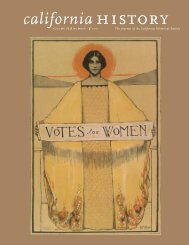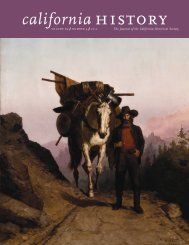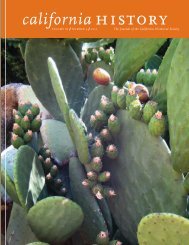Volume 90, Number 1 - California Historical Society
Volume 90, Number 1 - California Historical Society
Volume 90, Number 1 - California Historical Society
Create successful ePaper yourself
Turn your PDF publications into a flip-book with our unique Google optimized e-Paper software.
hoBoes, Bindlestiffs,<br />
fruit tramps, and the<br />
harVesting of<br />
the West<br />
By Mark Wyman (New York: Hill<br />
and Wang, 2010, 368 pp., $28.00<br />
cloth, $16.00 paper, $9.99 eBook)<br />
hoBos to street<br />
people: artists’<br />
responses to<br />
homelessness from<br />
the neW deal to the<br />
present<br />
By Art Hazelwood (San Francisco:<br />
Freedom Voices, 2011, 84 pp., $25.95<br />
paper)<br />
REVIEWED BY CHRISTOPHER HERRING, PHD<br />
CANDIDATE OF SOCIOLOGY, UNIVERSITY<br />
OF CALIFORNIA, BERKELEY, AND ASSOCIATE<br />
RESEARCHER FOR THE NATIONAL COALITION<br />
FOR THE HOMELESS<br />
In their latest books, Mark<br />
Wyman and Art Hazelwood offer lucid<br />
portrayals of the most marginalized<br />
characters in the history of the American<br />
West and, in the wake of the Great<br />
Recession, provide valuable historical<br />
perspectives of the contemporary<br />
migrant worker and the homeless<br />
American.<br />
The men, women, and children variously<br />
called bindlestiffs, fruit tramps,<br />
bums, and hoboes were vital to the<br />
creation of the West and its economy,<br />
yet their history has been largely<br />
untold. In his book Hoboes, Bindlestiffs,<br />
Fruit Tramps, and the Harvesting of the<br />
West, veteran historian Mark Wyman<br />
provides this much-needed story of<br />
western development. The book’s narrative<br />
follows the symbiotic evolution<br />
of rails, crops, and labor. With refrigerated<br />
freight and massive irrigation<br />
projects across the West, family fields<br />
of a few hundred acres were converted<br />
to “bonanza” farms composed<br />
of thousands, small farmers became<br />
small capitalists, and local hires were<br />
replaced by traveling flocks of seasonal<br />
labor. In the spirit of historian Howard<br />
Zinn, Wyman offers an alternative history<br />
of the West’s development from<br />
below, tracing the migrations and<br />
struggles of the floating proletariat<br />
that harvested America’s breadbasket,<br />
orchards, and forests from the Civil<br />
War to the 1920s.<br />
Although Hoboes is singularly emblazoned<br />
on the book’s spine, the work<br />
focuses equally on migrating families<br />
A bindlestiff walks from the mines to the lumber camps to the<br />
farms in Napa Valley in 1938.<br />
Library of Congress; photograph by Dorothea Lange<br />
71









